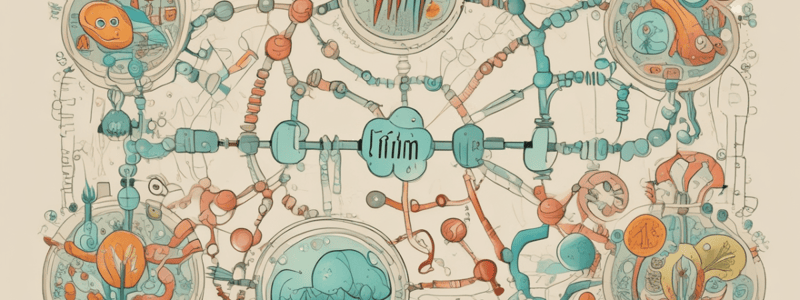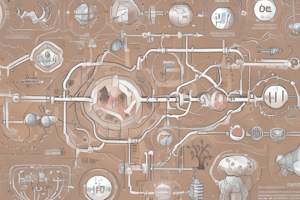Podcast
Questions and Answers
Which compound is generated in the first step of the urea cycle?
Which compound is generated in the first step of the urea cycle?
- carbamoyl phosphate (correct)
- ornithine
- alpha-ketoglutarate
- citrulline
What is the intermediate to which the amino group is transferred during the removal process?
What is the intermediate to which the amino group is transferred during the removal process?
- Glutamine
- Alpha-ketoglutarate (correct)
- Aspartate
- Oxaloacetate
What is the final product of glycolysis?
What is the final product of glycolysis?
- glyceraldehyde 3-phosphate
- fructose 6-phosphate
- pyruvate (correct)
- glucose
Which amino acid's breakdown produces pyruvate and can also be used for gluconeogenesis?
Which amino acid's breakdown produces pyruvate and can also be used for gluconeogenesis?
Which enzyme class involves the rearrangement of a single substrate to generate isoforms?
Which enzyme class involves the rearrangement of a single substrate to generate isoforms?
What happens to alanine during rapid muscle contraction?
What happens to alanine during rapid muscle contraction?
From which molecule is aspartate made that funnels into the urea cycle?
From which molecule is aspartate made that funnels into the urea cycle?
What byproduct is generated during the breakdown of 19 of the 20 amino acids?
What byproduct is generated during the breakdown of 19 of the 20 amino acids?
Which step immediately follows ornithine in the urea cycle?
Which step immediately follows ornithine in the urea cycle?
Which cycle involves converting alanine to glucose in the liver?
Which cycle involves converting alanine to glucose in the liver?
In the presence of which enzyme is alanine converted back to pyruvate in the liver?
In the presence of which enzyme is alanine converted back to pyruvate in the liver?
Which amino acids can enter the TCA cycle directly?
Which amino acids can enter the TCA cycle directly?
Which of the following is generated during the pay-off phase of glycolysis?
Which of the following is generated during the pay-off phase of glycolysis?
What is the role of ligases in biochemical reactions?
What is the role of ligases in biochemical reactions?
Which intermediate is generated in the next step after oxoacetate?
Which intermediate is generated in the next step after oxoacetate?
What is the major function of hydrolases?
What is the major function of hydrolases?
Study Notes
How to Get Rid of the Amine?
- Amine groups are removed from amino acids by transferring them to alpha-ketoglutarate, generating glutamate.
- This process allows the amino acid to enter the urea cycle with another molecule.
Breakdown to NH₄⁺: 19 Amino Acids
- 19 amino acids break down to NH₄⁺.
Breakdown to NH₄⁺: Alanine (a Special Case)
- Alanine is broken down to pyruvate, which can be converted to glucose through gluconeogenesis or used to generate energy.
- Alanine is a breakdown product from muscles during exercise, which can then be used to make more pyruvate.
Breakdown to NH₄⁺: Glucose-Alanine Cycle
- Rapidly contracting muscle generates excess pyruvate and NH₂⁺.
- Pyruvate is converted to alanine by amino-transferase.
- Alanine is transported to the liver, where it is converted back to pyruvate.
- Pyruvate is then converted to glucose through gluconeogenesis.
- Glucose is transported back to the muscle for glycolysis to generate energy.
Urea Cycle
- The amino group is added to alpha-ketoglutarate to generate glutamate.
- The reverse reaction can be done to get glutamate back.
- Glutamate is used to shuttle the amino group around.
- The first step of the urea cycle is generating carbamoyl phosphate.
- This process requires energy.
Kreb Cycle
- Glucogenic amino acids can enter the TCA cycle directly.
- Ketogenic amino acids do not have to go through the same process.
Glycolysis: Preparatory and Pay-off
- Glucose is converted to glyceraldehyde 3-phosphate.
- Glucose 6-phosphate is converted to 1,3-bisphosphoglycerate.
- Fructose 6-phosphate is converted to 3-phosphoglycerate.
- Fructose 1,6-bisphosphate is converted to 2-phosphoglycerate.
- Glyceraldehyde 3-phosphate is converted to phosphoenolpyruvate.
- Dihydroxyacetone phosphate is converted to pyruvate.
Enzymes/Delta G
- Oxidoreductases transfer electrons via oxidation or reduction.
- Transferases transfer chemical groups from one molecule to another.
- Hydrolases cleave a substrate using water.
- Lyases add groups to double bonds or form double bonds by removing groups.
- Isomerases rearrange a single substrate, generating isoforms.
- Ligases join two substrates, often by eliminating water.
Urea Cycle (continued)
- The first step is ornithine to citrulline, which generates ornithosuccinate.
- Aspartate is made from oxoacetate in the TCA cycle.
- Aspartate is used to funnel into the urea cycle.
- The final step generates the starting product, with one amino group coming from the amino acids and the other from aspartate.
Studying That Suits You
Use AI to generate personalized quizzes and flashcards to suit your learning preferences.
Description
This quiz explores the process of removing amino groups from amino acids and transferring them to other intermediates, ultimately leading to the urea cycle.



